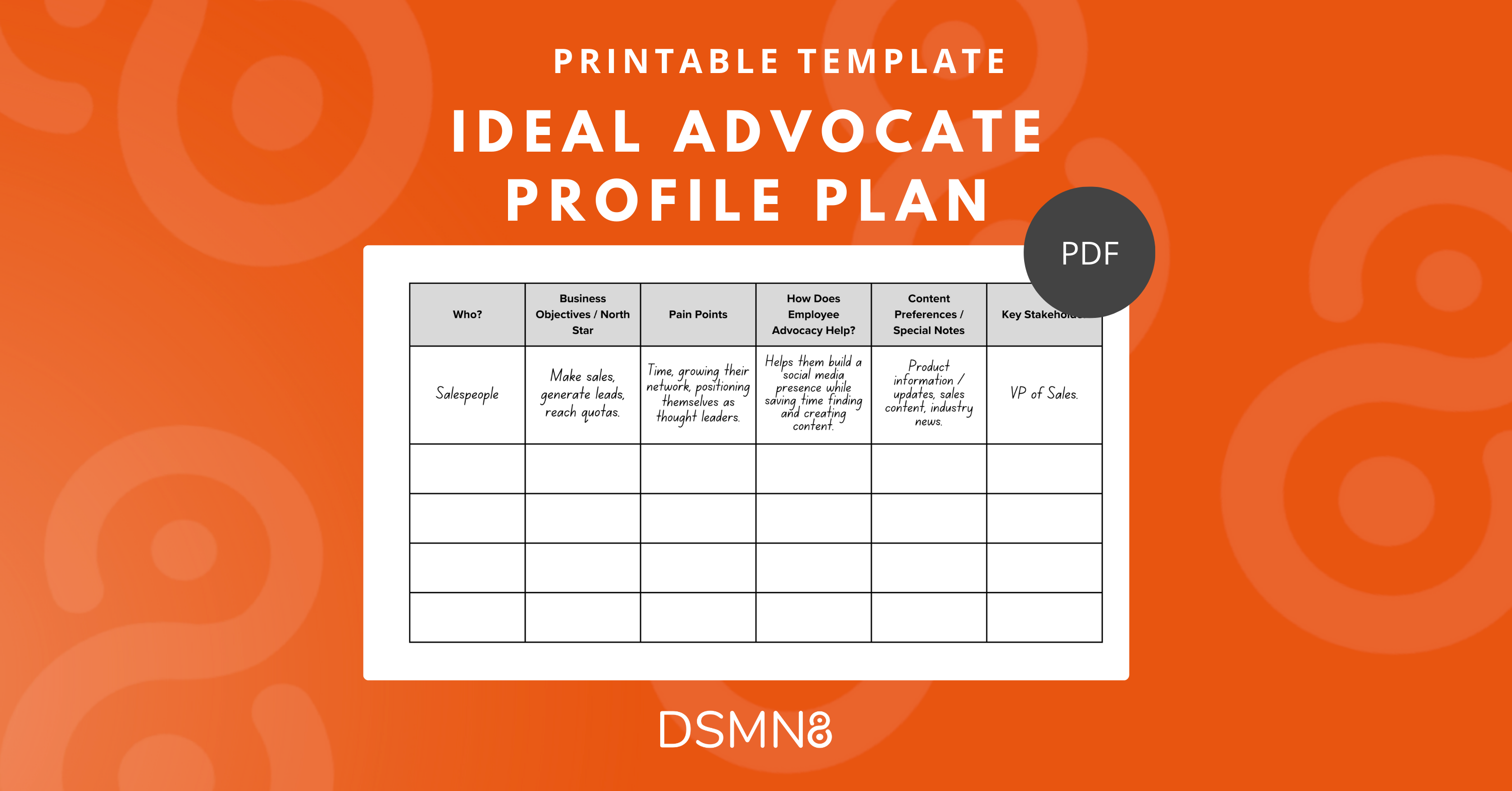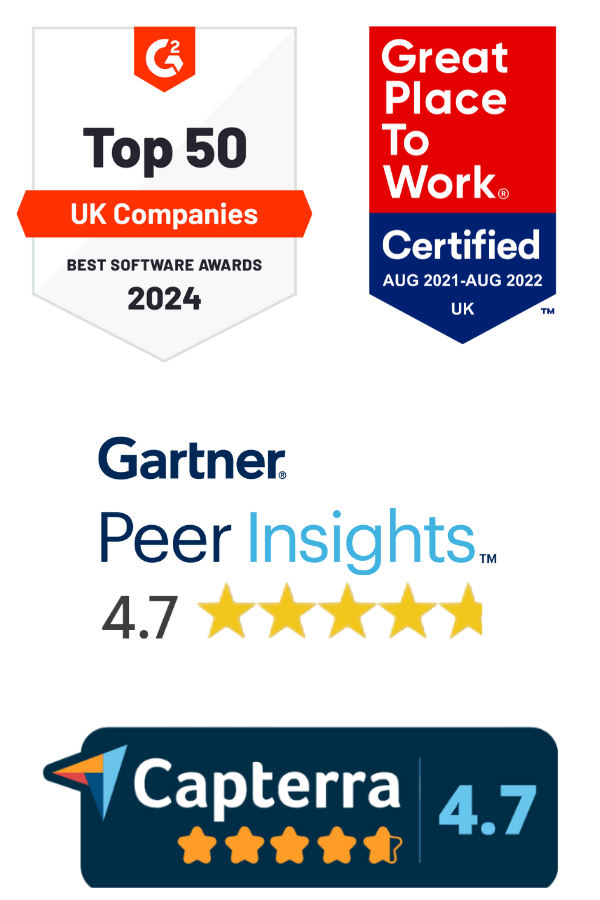
Maybe you’re brand new to employee advocacy, or perhaps you’re looking to scale up your existing program. Either way, you’ll need to prioritize inviting the best potential advocates in your organization to get involved.
When managing an employee advocacy program without software in place, you’re likely to have a limited number of employees you can realistically invite.
Tracking results and monitoring participation becomes challenging with more than around 20 advocates, unless you’re using an employee advocacy platform. So you need to be selective with who you invite.
As you start seeing success with employee advocacy, you’ll be able to demonstrate the impact, and gain leadership buy-in to scale your program throughout your organization.
But it’s always best to start small and scale, rather than inviting everyone from the get-go.
Initially, prioritize inviting the right employees to join. The ones who have internal influence, the potential to become thought leaders on social media, and most importantly, the ones who will benefit the most from employee advocacy.
So, how can I find these people?
By creating ideal advocate profiles.
If you’re a listener of the Employee Advocacy & Influence podcast, you’ll have heard all about ‘ideal advocate profiles’ by now.
But for those who don’t know, or need a quick refresher, this is what I’m talking about:
Sales and marketing teams often put together personas to determine who their target audience is.
These personas are a representation of a group or individual, highlighting what their pain points (problems) are, and how your product/service can solve these issues.
Building out detailed personas provide a way for sales and marketing to tailor their approach to different groups. For example, you could target your various personas with different email sequences, content written with them in mind, or PPC campaigns.
Let’s apply this concept to your employee advocacy program.
- Who would benefit the most from sharing social media content in your organization?
- What are their pain points or blockers to being more active on social, and how can your advocacy program help alleviate them?
- What social media content would they be interested in sharing, and how would it help them reach their goals or targets?
To help you answer these questions, follow the step-by-step guide to finding your best potential brand ambassadors below, and download the PDF worksheet to fill out.
Step 1: Discover Your Ideal Advocates
When looking for the best potential advocates for your program, start by thinking about the business objectives for each department.
Who would benefit the most from advocacy? Write down a list of these people (use the template!), and what their North Star is.
Prime examples would be Sales, Marketing, Recruitment, HR/Employer Branding, and Senior Leadership.
Let’s break it down:
Sales want to build relationships, and be front-of-mind when a prospect is ready to buy. Their North Star is generating leads and converting them into customers.
Marketing want the content they create to be seen and engaged with. Their North Star is increasing brand awareness, website traffic, and generating inbound leads.
Recruiters want to reach top talent and fill positions quickly and cost-effectively. Their North Star is to fill open positions with the right hires.
HR and Employer Branding want to showcase your company as a great place to work. Their North Star is creating a positive reputation of your organization as an employer.
Senior Leadership want to reach top talent and present a positive image of your organization. Their North Star is reaching business objectives.
Now, let’s also consider what your goals are as an employee advocacy program manager.
Your goals are likely to be:
1) getting employees involved.
2) demonstrating the impact to senior leadership. This is especially important if you’re aiming to scale advocacy throughout your organization.
To find out what metrics you should be tracking, especially at the beginning of your journey, have a read of the guide to measuring employee advocacy success.
Now we’ve covered some of the groups that would benefit the most from joining your program, you’ll need to consider the people who will help you drive results, whether that’s by generating inbound leads, increased website traffic, or any other KPIs you’re tracking.
Marketing and sales will be a no-brainer, but don’t limit your program to solely the obvious candidates.
Have a look at who in your organization is currently active on LinkedIn – you may have a hidden influencer among your ranks!
And the one thing that’s critical is getting leadership on board. It sets the tone for your advocacy program: this isn’t just a new marketing fad, it’s an initiative supported by the CEO and department heads.
Step 2: List Their Pain Points & How Advocacy Helps Them
After establishing which departments or individuals in your organization would make the best potential advocates, you’ll need to discover their pain points.
This will help you position employee advocacy as a solution to the issues they currently face when reaching out to them.
Let’s use sales teams as an example.
Their biggest pain point is that they’re time-poor. Building relationships takes time and effort, and so does converting leads into customers.
They’re likely to know that growing their social media influence will hugely benefit them, but they may not feel they have enough time to truly invest in it.
In this scenario, an employee advocacy program will help them maintain an active social media presence, without having to source or create content to share themselves.
They need to be able to educate their audience to position themselves as thought leaders, as well as provide valuable resources to help prospects at all stages of the buying journey.
Step 3: What Content Would They Want To Share?
This step is really important.
There’s no point finding your ideal advocates, and telling them why advocacy will help them reach KPIs, if you don’t have any suitable content for them to share.
Going back to the sales example, have a think about what types of content your sales team will want to share.
It’s likely to be very different to the content that an engineer would share.
Don’t just assume that salespeople will be happy to share any and all marketing content you produce.
Sales is all about building relationships, so the last thing your sales team want to do is overwhelm their LinkedIn feed with marketing content – it could potentially turn away their prospects!
When creating or curating content for salespeople, always focus on providing value to the reader. Educational content and resources for people in all stages of the sales funnel or buying journey is the way to go.
Have a read of the guide to employee advocacy content to learn more about the content you’ll need to create.
You’ll also need to consider the seniority of your advocates, as this does affect the content that will work well for their audience.
Let’s consider the VP of Sales for example:
Yes, they’ll want to share educational content.
But, as a key stakeholder within the organization, they also may want to share company insights. Things like reports on revenue, acquisition, senior executive new hires, and general company announcements.
It makes sense for them to share this kind of content, whereas it might look a bit strange coming from an intern. And due to their position, they’re likely to be connected with others in their industry with a similar level of authority, who are likely to be interested in these types of posts.
Step 4: Who Is The Gatekeeper To This Person? How Will You Approach Them?
Let’s recap: You’ve discovered who your ideal employee advocates are, you know their pain points and how advocacy will help alleviate them. You know what types of content they would want to share.
So what’s left?
Planning how to invite them to participate. (Grab the Employee Advocacy User Adoption Playbook for ideas!)
You’ll want to go in with a game plan, highlighting why they should become advocates, emphasizing how it will benefit them.
But there’s one more thing to do first.
Find out who the gatekeeper to this person is. Gatekeeper sounds scary, but what I mean is, who is this person’s manager or head of department?
It’s essential to not only know this, but to approach them first.
There’s no use asking sales development reps to become employee advocates if the Head of Sales isn’t keen on the idea.
Besides, if advocacy is supported by their direct manager, employees are much more likely to get involved, and view it as part of their regular work duties.
When approaching the gatekeeper to your ideal advocates, consider all the elements you’ve put together in your ideal advocate profile.
A tailored approach is essential.
Emphasize how advocacy will help move the needle in terms of reaching departmental KPIs and overall business objectives.
Finally, show them the types of content you would create/curate for their team.

Get the PDF Worksheet 👇
To help with planning out your ideal advocate profiles, you can download the printable PDF below.
I recommend creating 4-5 of these before inviting any employees to join your advocacy program.
It’ll help you prioritize onboarding those who will help generate the best results, and give marketing an indicator of the content you’ll need for those groups/individuals!
Final Thoughts & Additional Resources
Need some more guidance finding the best potential advocates and understanding how to use personas for employee advocacy?
We’ve got not one, but two podcast episodes on this topic! 👏
It’s worth giving these a listen for insights coming directly from CEO Bradley Keenan, and Senior Marketing Manager, Lewis Gray.
I also recommend giving The Pyramid of Employee Influence a read, it’ll help you understanding the motivations of employees, and whether they’d be interested in joining your program.
Finally,I’d recommend our User Adoption Playbook, which reveals a 4-step strategy for creating an engaged community of employee advocates.
Whether you’re just launching an employee advocacy program, or you’ve been managing one for a while, you’ll find something helpful in our Resource Hub and Templates Gallery.
Here are some top picks:
Want to take employee advocacy to the next level?
We can help with that! 👋
Choose a time to speak with the team.
Prefer to jump straight in?
Book a Demo of DSMN8, the all-in-one Employee Advocacy Platform.
Emily Neal
SEO and Content Specialist at DSMN8. Emily has 10 years experience blogging, and is a pro at Pinterest Marketing, reaching 1 million monthly views. She’s all about empowering employees to grow their personal brands and become influencers.


